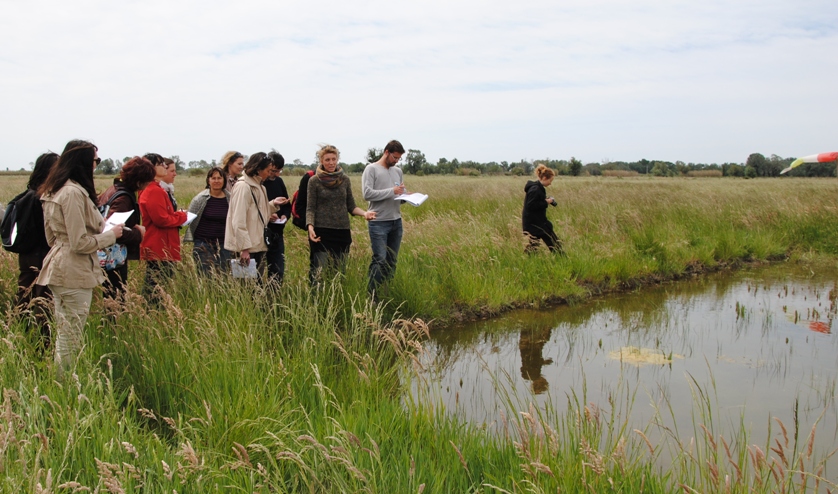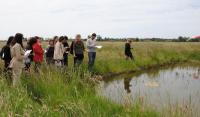The rehabilitation of a former farming site into a wetland for ecological conservation and hunting
Except for the relict dunes, which have been partly destroyed by the sand extraction, and a few hectares of sansouïre, the vast majority of the site had been used for various farming activities since the middle of the 18th century, in particular vineyards and cereal growing (rice until 2004). These activities resulted in the major degradation of the environment due to ground levelling operations and various inputs. This restoration project has a twofold objective: on the one hand, it is a matter of increasing the natural heritage value of these former crop growing areas, and, on the other hand, to satisfy the request of a hunting association in the nearby hamlet of Mas Thibert (commune of Arles), which would like to have a marsh for waterfowl hunting.
The management of hunting marshes as it is most often practiced in the Camargue is based on maintaining the parcels flooded during the hottest months. This type of management, which leads to habitat conditions opposite to those encountered in natural marshes, characterised by a dry summer period, has definite consequences on the flora. Mediterranean species, which are adapted to dry summer periods, and irregular and often limited periods of flooding, are replaced by common and ubiquistic species. In addition, the presence of water at the end of spring and during the summer facilitates the development of undesirable and/or exotic and potentially invasive species.
A dual ecological and hunting issue
 Two issues are therefore at stake in this rehabilitation project: with hydrological management that mirrors the conditions encountered in natural environments, demonstrate that it is possible to obtain plant communities with a high natural heritage value, while at the same time ensuring that the area remains in good condition for hunting activities.
Two issues are therefore at stake in this rehabilitation project: with hydrological management that mirrors the conditions encountered in natural environments, demonstrate that it is possible to obtain plant communities with a high natural heritage value, while at the same time ensuring that the area remains in good condition for hunting activities.
Considerable investments were made for the preparatory studies on the nature and impermeability of the soil (precise identification of the distribution in the clay layer), the plant matrix (presence and/or proximity of target species, or on the contrary undesirable ones), the seed bank, and on decreasing the amount of money spent on fossil fuels during the works phase (choice of depth and areas dug, minimum moving of earth).
A set of studies has been put in place within the framework of a thesis in the aim of first of all better understanding the mechanisms at play and the dynamics involved so as to explain potential problems, such as unexpected colonisation, potential invasion, or a blocking phase, and, then, guide the thought process shaping the adaptive management of this site after its rehabilitation.
In particular, these studies focus on:
- The history of the site over the past 50 years (farming practices, methods…);
- Controlled tests on the role of the hydrological management on the expression of the seed bank and the particular roles played by wind and water;
- Mesocosm tests (in artificial ecosystems) on the rehabilitation of temporary ponds and xeric grasslands in the Camargue, which are the two most highly threatened local habitats.
 At the site scale, the project is testing the pertinence of management techniques that are more or less ‘interventionist’: evaluating the gains (speed at which desired communities are obtained, permeability to undesirable species), and constraints (time, budget, ease of realisation…) as a function of how densely seeds are introduced, the areas seeded or inoculated (small vs large areas), and the spatial distribution of these seeded or inoculated areas.
At the site scale, the project is testing the pertinence of management techniques that are more or less ‘interventionist’: evaluating the gains (speed at which desired communities are obtained, permeability to undesirable species), and constraints (time, budget, ease of realisation…) as a function of how densely seeds are introduced, the areas seeded or inoculated (small vs large areas), and the spatial distribution of these seeded or inoculated areas.
At the same time, experiments and monitoring operations on the vegetation dynamics, the wildlife using these habitats, and the hunting activities there have been set up (number of hunters using the site and dates, number and nature of animals taken).
The engineering work began on the site in April, 2012, but only on 4 of the planned 35 hectares. The second restoration phase is scheduled for 2013.
Some promising initial results
Initial results are promising, because for the two major target habitats, many of the desired species have already started growing (39% of the species in the reference ecosystems for the grasslands). Nonetheless, the success of a restoration project cannot even be evaluated over only a few years, so even less so over only a few months. Several years of monitoring will therefore be necessary before initial conclusions can be drawn. Likewise, research and monitoring work, which is the fruit of close collaboration between the The Friends of the Marshes of Vigueirat Association, the Tour du Valat, and the Laboratory of Natural and Cultural Heritage Restoration Engineering of the University of Avignon and the Vaucluse (IMBE), have been scheduled until 2017.
This restoration project is based on dialogue, and a steering committee has been set up for that purpose bringing together the French Coastal Protection Agency (CdL) (site owner), The Friends of the Marshes of Vigueirat Association (managing authority), the Mas Thibert Hunting Association, the French National Hunting and Wildlife Agency (ONCFS), the Tour du Valat research centre for the conservation of Mediterranean wetlands, and the IMBE (Mediterranean Institute of Marine and Terrestrial Biodiversity and Ecology).
The project has received funding from several institutions, including the French Coastal Protection Agency (CdL) for the initial studies, the Water Agency for the ecological engineering phase, and the Provence-Alpes-Côte d’Azur regional government, which is funding a doctoral thesis.